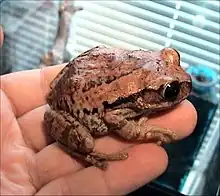Leptopelis
Leptopelis is a genus of frogs in the family Arthroleptidae. They are found throughout Sub-Saharan Africa,[1] excluding Madagascar.[2] It is placed in monotypic subfamily Leptopelinae,[3][4] although this subfamily is not always recognized.[2] They have a number of common names, including forest treefrogs, tree frogs, leaf-frogs,[1] and big-eyed frogs.[5]
| Leptopelis | |
|---|---|
 | |
| Leptopelis aubryi, the type species | |
| Scientific classification | |
| Domain: | Eukaryota |
| Kingdom: | Animalia |
| Phylum: | Chordata |
| Class: | Amphibia |
| Order: | Anura |
| Family: | Arthroleptidae |
| Subfamily: | Leptopelinae Laurent, 1972 |
| Genus: | Leptopelis Günther, 1859 |
| Type species | |
| Hyla aubryi Duméril, 1856 | |
| Species | |
|
54 species (see text) | |
| Synonyms[1] | |
| |
Description
Leptopelis are mostly medium-sized frogs (snout–vent length 26–42 mm (1.0–1.7 in)), but Leptopelis palmatus can reach 87 mm (3.4 in).[4] Tympanum is present. Most species have expended digit tips.[2]
Ecology
Leptopelis are mainly arboreal, but some species, especially in more arid areas, are terrestrial or even subfossorial.[2][4] Breeding typically starts with the heavy rains in the beginning of the wet season. Eggs may be deposited either in water or in/on the ground. Development includes a free-living tadpole stage, with a possible exception of Leptopelis brevirostris, whose large eggs suggest that development could be direct.[4] Males typically call in bushes or trees a meter or more above the ground.[2]
Species
As of July 2021, there are 54 recognized species:[1]
- Leptopelis anchietae (Bocage, 1873)
- Leptopelis anebos Portillo and Greenbaum, 2014
- Leptopelis argenteus (Pfeffer, 1893)
- Leptopelis aubryi (Duméril, 1856)
- Leptopelis aubryioides (Andersson, 1907)
- Leptopelis bequaerti Loveridge, 1941
- Leptopelis bocagii (Günther, 1865)
- Leptopelis boulengeri (Werner, 1898)
- Leptopelis brevipes (Boulenger, 1906)
- Leptopelis brevirostris (Werner, 1898)
- Leptopelis broadleyi (Poynton, 1985)
- Leptopelis bufonides Schiøtz, 1967
- Leptopelis calcaratus (Boulenger, 1906)
- Leptopelis christyi (Boulenger, 1912)
- Leptopelis concolor Ahl, 1929
- Leptopelis crystallinoron Lötters, Rödel, and Burger, 2005
- Leptopelis cynnamomeus (Bocage, 1893)
- Leptopelis diffidens Tiutenko and Zinenko, 2021
- Leptopelis fenestratus Laurent, 1972
- Leptopelis fiziensis Laurent, 1973
- Leptopelis flavomaculatus (Günther, 1864)
- Leptopelis gramineus (Boulenger, 1898)
- Leptopelis grandiceps Ahl, 1929
- Leptopelis jordani Parker, 1936
- Leptopelis karissimbensis Ahl, 1929
- Leptopelis kivuensis Ahl, 1929
- Leptopelis lebeaui (De Witte, 1933)
- Leptopelis mackayi Köhler, Bwong, Schick, Veith, and Lötters, 2006
- Leptopelis macrotis Schiøtz, 1967
- Leptopelis marginatus (Bocage, 1895)
- Leptopelis millsoni (Boulenger, 1895)
- Leptopelis modestus (Werner, 1898)
- Leptopelis montanus Tiutenko and Zinenko, 2021
- Leptopelis mossambicus Poynton, 1985
- Leptopelis mtoewaate Portillo and Greenbaum, 2014
- Leptopelis natalensis (Smith, 1849)
- Leptopelis nordequatorialis Perret, 1966
- Leptopelis notatus (Peters, 1875)
- Leptopelis occidentalis Schiøtz, 1967
- Leptopelis ocellatus (Mocquard, 1902)
- Leptopelis oryi Inger, 1968
- Leptopelis palmatus (Peters, 1868)
- Leptopelis parbocagii Poynton and Broadley, 1987
- Leptopelis parkeri Barbour and Loveridge, 1928
- Leptopelis parvus Schmidt and Inger, 1959
- Leptopelis ragazzii (Boulenger, 1896)
- Leptopelis rufus Reichenow, 1874
- Leptopelis spiritusnoctis Rödel, 2007
- Leptopelis susanae Largen, 1977
- Leptopelis uluguruensis Barbour and Loveridge, 1928
- Leptopelis vannutellii (Boulenger, 1898)
- Leptopelis vermiculatus (Boulenger, 1909)
- Leptopelis viridis (Günther, 1869)
- Leptopelis xenodactylus Poynton, 1963
- Leptopelis yaldeni Largen, 1977
- Leptopelis zebra Amiet, 2001
In captivity
L. vermiculatus is found in international pet trade.[6] They are hardy frogs that adapt well to captivity, and readily consume commercially available crickets.
References
- Frost, Darrel R. (2018). "Leptopelis Günther, 1859". Amphibian Species of the World: an Online Reference. Version 6.0. American Museum of Natural History. Retrieved 20 May 2018.
- Blackburn, David C. (2011). "Family Arthroleptidae". AmphibiaWeb. University of California, Berkeley. Retrieved 20 May 2018.
- Frost, Darrel R. (2018). "Leptopelinae Laurent, 1972". Amphibian Species of the World: an Online Reference. Version 6.0. American Museum of Natural History. Retrieved 20 May 2018.
- Vitt, Laurie J. & Caldwell, Janalee P. (2014). Herpetology: An Introductory Biology of Amphibians and Reptiles (4th ed.). Academic Press. pp. 514–515.
- "Big-eyed Frogs (Genus Leptopelis)". iNaturalist. Retrieved 20 May 2018.
- IUCN SSC Amphibian Specialist Group (2014). "Leptopelis vermiculatus". IUCN Red List of Threatened Species. 2014: e.T56284A3037319. doi:10.2305/IUCN.UK.2014-1.RLTS.T56284A3037319.en.
_(7073641407).jpg.webp)
